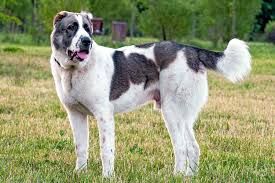
Central Asian Shepherd Dog
Conditions of detention
The Central Asian Shepherd Dog thrives in rural or suburban environments where it has plenty of space to roam and exercise.
Useful Fact: These dogs are best suited for homes with large yards or access to open spaces, as they need ample room to move around and perform their guarding duties.
Nutrition and diet
A well-balanced diet rich in protein and essential nutrients is crucial for maintaining the health and energy levels of the Central Asian Shepherd Dog.
Useful Fact: High-quality commercial dog food or a carefully planned homemade diet can meet their nutritional needs. Regular monitoring of their diet helps maintain optimal health and prevent obesity.
Health
The Central Asian Shepherd Dog is generally robust but can be prone to hip dysplasia, elbow dysplasia, and certain genetic conditions.
Useful Fact: Regular veterinary check-ups and genetic screenings can help detect and manage potential health issues early, ensuring a longer, healthier life for your dog.
Grooming and care
The Central Asian Shepherd Dog has a dense, double-layered coat that can be short, medium, or long. Coat colors vary widely, including white, black, brindle, fawn, and gray.
Useful Fact: Regular brushing, at least once a week, helps manage shedding and keeps the coat healthy. More frequent grooming may be necessary during seasonal shedding periods.
Education and training
Central Asian Shepherd Dogs are intelligent and independent, requiring firm and consistent training from an early age.
Useful Fact: Early socialization and positive reinforcement training are essential to manage their strong protective instincts and ensure they become well-behaved companions.
Toys and entertainment
These dogs enjoy activities that stimulate their mind and body, such as interactive toys, fetch games, and agility exercises.
Useful Fact: Providing a variety of toys and engaging in regular playtime helps keep them mentally stimulated and physically fit, preventing boredom-related behaviors.
Safety
Central Asian Shepherd Dogs are naturally protective and can be wary of strangers. Socialization is crucial to ensure they distinguish between friend and foe.
Useful Fact: Secure fencing in the yard is vital to prevent them from wandering off or reacting aggressively to perceived threats, ensuring their safety and that of others.
Accessories
Durable collars, leashes, and harnesses are essential, along with sturdy food and water bowls and a comfortable bed.
Useful Fact: Using a strong, well-fitted harness can provide better control during walks and is often more comfortable for these large and powerful dogs than a collar alone.
Socialization
Early and consistent socialization with a variety of people, animals, and environments helps ensure a well-rounded and balanced temperament.
Useful Fact: Puppy classes and regular exposure to new experiences can significantly improve their social skills and confidence, making them well-adjusted adults.
Travel and Transportation
Central Asian Shepherd Dogs can travel well if accustomed to it from a young age. Ensure they are comfortable and secure during travel.
Useful Fact: Using a spacious crate or dog seat belt can enhance safety and comfort during car rides, reducing anxiety and ensuring a pleasant travel experience.
Behavior and psychology
These dogs are loyal, protective, and have a high energy level. They thrive on having a job to do and need regular mental and physical stimulation.
Useful Fact: Understanding their need for activity and purpose can help in providing appropriate outlets for their energy, such as herding or watchdog duties.
Legal aspects
Check local regulations regarding ownership of large breeds and any specific requirements for registration, vaccination, and containment.
Useful Fact: Some regions may have breed-specific legislation, so it’s important to be aware of and comply with local laws to avoid legal issues.


